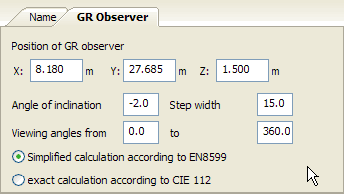- Главная
-
Учебник
- DIALux 4
- DIALux evo
- IES
- Форум
- Галерея
- Блоги
-
Скачать
- DIALux
- Базы
- Плагины
- 3D модели
- Текстуры
- Книги
-
Новости
Glare Rating
30 августа 2012 - АдминThe draft of EN 12464-2 / EN 8995-2 intends that glare has to be avoided for outdoor working places. To ensure this, glare limits for tasks and activities are prescribed. The glare rating system (GR) is defined in the CIE publication 112:1994. For glare evaluation, the veiling luminances produced by the luminaires and by the environment are the basic criteria. The latter is handled differently by EN 12464-2. In DIALux you can choose, whether you want to use the simplified method of EN or the complete method of CIE. The simplified method approximates the veiling luminance produced by the environment (Lve) with the formula Lve=0.035 x ρ x Ehav x π, where ρ is the average reflection and Ehav the average illuminance of the “area”. Unfortunately this “area” is not exactly defined. DIALux uses all ground elements as the “area”.
The complete method of CIE 112:1994 uses the correct veiling luminance produced by the environment in front of an observer. Here the illuminated area is considered to consist of an infinite number of small light sources. The veiling luminance produced by the environment is defined by the formula where n is the total number of small light sources. Of course, this calculation is more accurate but more time consuming too. The DIALux outputs state which method was used to calculate GR values.
where n is the total number of small light sources. Of course, this calculation is more accurate but more time consuming too. The DIALux outputs state which method was used to calculate GR values.

Fig. 307 Property page of the GR Observer
To calculate GR values, DIALux provides the GR observer tab. Any GR observer can be placed just like any other calculation point. There are some special properties, an inclination angle, viewing angles from a start to an end angle and a step width. The inclination angle defines the observer’s viewing direction towards the horizontal. Start and end angle define the observer’s vertical viewing section. Here 0° is the direction along the positive X-axis, positive angles move counter clockwise. Step width defines the different viewing directions between start and end angle.
GR observers can easily be placed as a line or even as a field by using the function “Copy along a line”.Рейтинг: 0 Голосов: 0 15293 просмотраКомментарии (0)Manual
